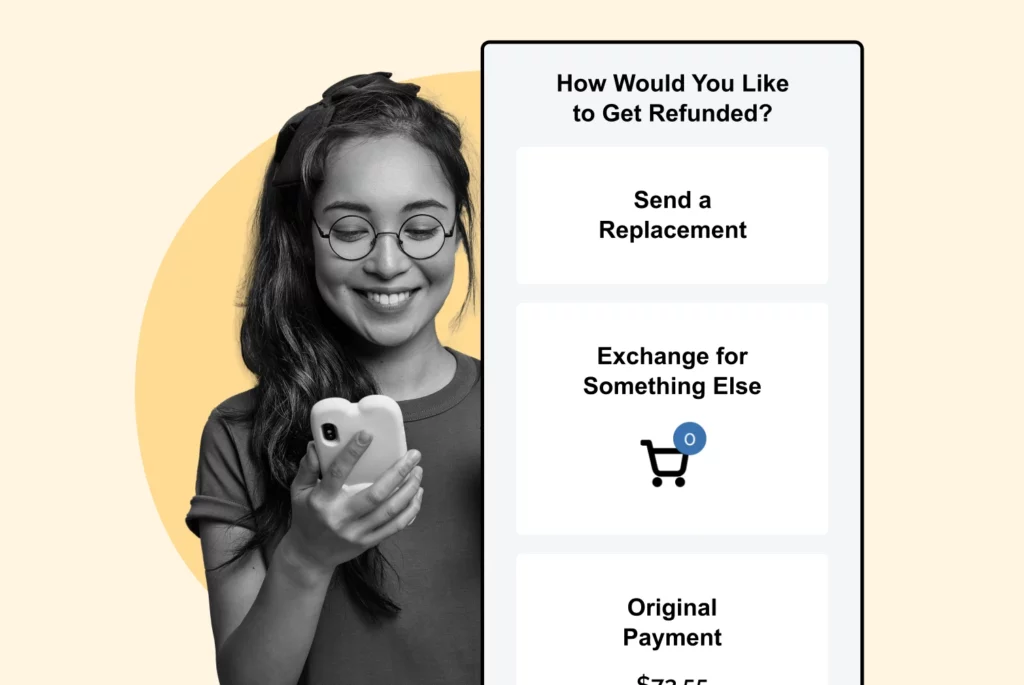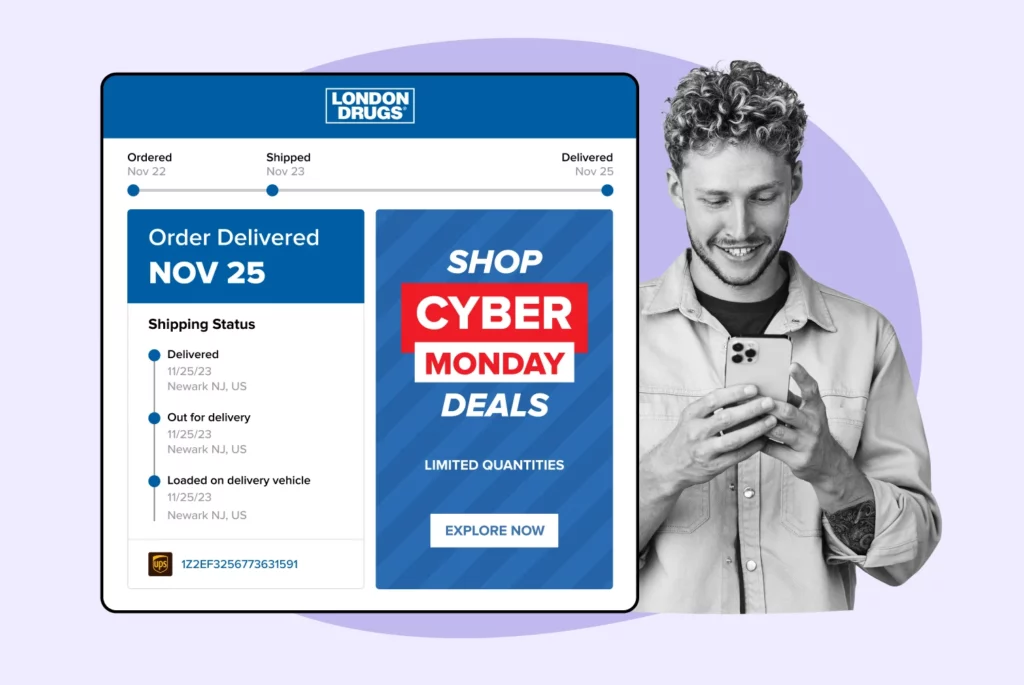
Decoding Customer Churn in Ecommerce: Shopify Store Insights
Get ready to transform your ecommerce store by turning churn challenges into opportunities!
Boost customer experience and reduce support tickets
Realtime order and shipment tracking
Proactive order and shipping notifications
Predictive pre-purchase estimated delivery dates
Self-Serivce branded order tracking
Effortless experience delivered
Make returns profitable and delight customers
Flexibility to define any return destinations & conditions
Simplify returns for your customers and team
Incentivize exchanges over returns
Returns management made easy for your team
Understand why your customers are returning
Unify the online and the in-store experience
Hassle-free pickup experience for customers
In-Store Dashboard to keep operations streamlined
In-Store and Online orders unified
Drive foot-traffic to your stores
Boost customer experience and reduce support tickets
Realtime order and shipment tracking
Proactive order and shipping notifications
Predictive pre-purchase estimated delivery dates
Self-Serivce branded order tracking
Effortless experience delivered
Make returns profitable and delight customers
Flexibility to define any return destinations & conditions
Simplify returns for your customers and team
Incentivize exchanges over returns
Returns management made easy for your team
Understand why your customers are returning
Unify the online and the in-store experience
Hassle-free pickup experience for customers
In-Store Dashboard to keep operations streamlined
In-Store and Online orders unified
Drive foot-traffic to your stores
Find the answer to all your questions
Explore the most comon questions about WeSupply
Calculate the ROI that WeSupply can bring you
Request a no strings attached review of your current shopping experience and missed conversion opportunities
Take a step by step trip through our functionality to see how we can improve your ecommerce processes.
Read actionable articles on how to optimize your post-purchase experience and decrease support tickets
Get inspired by stories of how our customers implemented an effortless post-purchase experience
A Deep Dive into Top Companies' Order Tracking & Returns Strategy
Wondering if WeSupply is a good fit for you? Read through our use cases to see how we can help you increase conversion & improve CX!

Have you ever tried to return a product online and experienced the frustration of navigating a maze of complex return policies? You’re not alone. In the digital age, return policies can make or break a customer’s loyalty to a brand. Retailers that fail to address these concerns risk losing customers and damaging their reputations. In this blog post, we will unveil the six return experiences worst online and analyze the lessons learned from these retailers’ best and worst practices.
Understanding consumer and retail perspectives on return policy frustrations is essential for successful online shopping.
Retailers must balance customer satisfaction with profitability to ensure loyalty and positive brand image.
Consumers should research store policies, maintain receipts/packaging, and be aware of time constraints to navigate complex return policies.
WeSupply optimizes e-commerce returns with user-friendly, customizable policies, and smart routing, enhancing customer satisfaction while reducing fraud. Its emphasis on exchanges boosts sales and loyalty, and its analytics tools aid in strategy refinement. This streamlined approach improves the return experience and adapts to consumer needs.
Return policies significantly influence the customer experience, having an impact on customer loyalty and brand reputation. A recent Narvar survey revealed that the leading grievances when shopping online are having to pay for return shipping, lack of communication regarding return status, and uncertainty about when refunds will be received. One example is the luxury fashion retailer Aritzia, where customers reported dissatisfaction with their online return experiences, potentially leading to more discerning future purchases. As online shopping popularity expands, gaining insights into return policy frustrations from both consumer and retail perspectives becomes increasingly significant.
In the retail domain, return policies vary greatly. Major retailers like Amazon, Walmart, and Target strive to offer great return policies but can still fall short, leading to many customers voicing their complaints. Consumers also engage in bracketing, buying multiple items with the intention of returning some, a behavior driven by the lack of information provided by retailers, ultimately resulting in customers having to pay return shipping for unwanted items. To alleviate these frustrations, retailers need to reassess their return policies and place emphasis on customer satisfaction.
While Amazon is celebrated for its customer-centric return policy, it also faces certain challenges. Many items available on Amazon are sold by third-party vendors, who have their own return policies that can differ significantly from those of the online retail giant. Some third-party vendors may require customers to cover return shipping costs, have shorter-than-normal return windows, or refuse to accept returns altogether. Prolonged wait times and difficulty communicating with third-party sellers when returning items have been reported by customers, especially if the item was received as a gift without a gift receipt.
Conversely, Forever 21’s online return process has received criticism due to its stringent return demands. Customers often feel they have spent so much money on items that are difficult to return, causing frustration and dissatisfaction. The fashion retailer requires a receipt for all returns, and items must be in brand new condition with all labels and tags still attached. With such strict return policies, it’s no wonder customers are left feeling frustrated and reluctant to make future purchases.
Amazon’s third-party seller return policies can result in a multitude of customer complaints, including restocking fees, lack of control over returns, responsibility for refunds, difficulty in returning, and issues with product functionality or damage. To address these complaints, Amazon offers customers a prepaid label or a full refund and allows customers to file complaints through their A-to-Z claim process.
Conversely, Forever 21 has made minor modifications to its return policy, now allowing customers to receive a reimbursement in the same payment form used for the purchase when returning online orders. However, certain items, such as sale and clearance items, jewelry, and cosmetics, are not eligible for returns, which is a common practice among online retailers. Despite these changes, Forever 21’s strict return demands continue to frustrate customers, ultimately affecting their loyalty to the brand.
Apple’s return policy mandates that all returns be made within a two-week period, and the receipt must be presented. This relatively short return deadline is a primary reason customers are dissatisfied with Apple’s return experience. Payless Shoes, on the other hand, has a 15-day time limit for most items, a 14-day limit for cell phones and activated items, and restocking fees for certain items. Both retailers’ return policies impose deadlines and additional fees that can impact customer loyalty and brand image.
In analyzing the return policies of Apple and Payless Shoes, the impact of their quick return deadlines and additional fees on customer loyalty and brand reputation must be taken into account. While Apple’s customer satisfaction and loyalty have been steadily increasing over the years, demonstrating that customers have a favorable opinion of the brand, the two-week return policy may still be a point of contention for some. On the other hand, Payless Shoes’ return fees have negatively affected its brand image, with other factors such as its viral marketing campaign also playing a role.
Apple’s return deadlines have not significantly affected customer loyalty, as its customer satisfaction and loyalty have continued to grow over the years, showing that customers have a favorable opinion of the brand. The 14-day return policy and free returns offered by Apple help address customer concerns and maintain loyalty.
On the other hand, Payless Shoes’ return fees have had a negative impact on its brand image, with other factors like the viral marketing campaign where Payless Shoes tricked VIP shoppers into paying excessive prices for their shoes, further hurting its reputation.
The contrasting return policies of Apple and Payless Shoes demonstrate the importance of striking a balance between customer satisfaction and business profitability. Apple’s customer-oriented return policy fosters customer loyalty and a positive brand image, while Payless Shoes’ return policy, with its additional fees and lack of clarity, has resulted in decreased customer loyalty and a negative brand image.
Retailers must carefully consider their store’s return policy to maintain customer satisfaction while safeguarding their profit margins.
While Walmart and Target’s return policies are generally favorable, they are not flawless. Walmart has a 90-day return window for unopened items with a receipt, but the store reserves the right to deny a refund if there are too many returns made without a receipt. Target, on the other hand, also has a 90-day return window for unopened items with a receipt, but stores may refuse to provide a refund even if a receipt is presented. Both retailers’ return policies can impact consumer trust and experiences due to inconsistencies and conditions.
The varying policies and conditional returns of Walmart and Target can cause confusion and frustration among customers, ultimately affecting their trust in the retailers. Walmart has a 15-day return policy for certain items, such as computers, camcorders, GPS units and video game systems. A valid receipt is required for the returns. Similarly, Target stores may refuse to provide a refund even if a receipt is presented. These inconsistencies and conditions highlight the need for retailers to create more transparent and consistent return policies to maintain consumer trust and satisfaction.
Walmart’s diverse return policies can influence customer satisfaction in multiple ways. Here are some examples:
A more permissive return policy can boost customer satisfaction by providing a straightforward and convenient return process, giving customers the assurance that they can return items if they are not satisfied with their purchase.
Conversely, stricter return policies may lead to decreased customer satisfaction as customers may feel limited or discouraged from returning items.
Inconsistent return policies across different Walmart locations or online platforms can also have a detrimental effect on customer satisfaction, causing confusion and dissatisfaction.
Target’s conditional return stipulations, such as their one-year return policy for Target Owned Brand items and the acceptance of opened makeup returns within 90 days (or 120 days with a RedCard), have a positive effect on consumer trust by providing convenience and flexibility in the return process. However, the store’s discretion in refusing refunds even with a receipt can potentially harm customer trust and lead to dissatisfaction. As a result, retailers must strike a balance between offering flexible return policies and maintaining consistency to ensure customer satisfaction and trust.
The implementation of return policies has financial implications for both retailers and consumers. On average, returns cost businesses approximately 66% of the original item’s price, with additional costs related to:
Shipping
Restocking
Discounting
Liquidation
It has been estimated that retailers can incur considerable costs due to returns, with estimates ranging from $166 million to $101 billion for every $1 billion in sales. For consumers, the average cost of return processing for small and large retailers can be around 66% of the original item’s price or approximately $33 for a $50 product, depending on factors such as processing, transportation, restocking fees, and losses from liquidation.
Retailers need to thoughtfully balance their return policies to guarantee customer satisfaction while reducing the financial burden on their business. Allowing customers to return products easily and without difficulty can lead to improved customer satisfaction and loyalty, resulting in higher sales and repeat purchases. However, a lax return policy can also increase the number of returns, which can be costly for retailers. Returns can result in additional expenditures such as restocking fees, shipping costs, and potential loss of inventory value. As a result, retailers need to strike a balance between customer satisfaction and the costs associated with returns.
In order to minimize the financial impact of return policies, retailers can implement the following strategies:
Streamline the policy
Utilize returns as sales opportunities
Incorporate flexibility into the policy
Gather and utilize return data
Offer store credit as an alternative to refunds
By adopting these strategies, retailers can strike a balance between customer satisfaction and the financial impact of returns, ensuring a positive business-customer relationship.
WeSupply masterfully combines customer satisfaction with financial prudence in e-commerce return policies. Its system offers over 50 customizable policies and smart routing rules, streamlining the return process while cutting down on operating costs and manual handling. The platform reduces returns fraud, errors, and customer support interactions, handling product-specific restocking and vendor policies efficiently.
Further, WeSupply promotes converting returns into exchanges, incentivizing customers with instant store credit. This not only drives sales but also fosters customer loyalty by encouraging them to revisit the product catalog. Automatic conversion of refunds into store credits, gift cards, or coupon codes enhances repeat purchases.
Incentivize exchanges over returns
Book a quick call with our experts to see how WeSupply can help you save sales through exchanges and boost the average order value using instant store credit.
The platform’s Return Analytics provides deep insights into return trends, identifying commonly returned products, reasons for returns, and patterns of serial returners. This data helps businesses refine their return strategies, improving profit margins and reducing lost revenue. WeSupply’s approach to analyzing regional return data and understanding the financial impact of returns equips businesses with the tools to effectively reduce return rates. This strategic management of returns ensures a balance between a customer-friendly experience and the financial health of the business.
Creating a framework for effective, balanced return policies is necessary for retailers to sustain customer satisfaction and loyalty. By analyzing lessons learned from various retailers’ best and worst practices, retailers can create return policies that address common customer frustrations and ensure a positive customer experience. Some retailers with the most favorable return policies include:
Target
Walmart
Amazon
American Eagle
Athleta
Costco
Lands’ End
A retailer’s effective return policy should:
Explicitly indicate acceptance of returns and offer refunds or exchanges
Discourage fraudulent returns while ensuring smooth returns for legitimate cases
Display confidence in the products and be willing to stand by them
Strike a balance between the necessity to increase demand and the necessity to limit returns
Enhance customer likelihood to purchase from the store.
From a customer’s perspective, an effective return policy should involve:
Clear and transparent communication
An easy and convenient process
A fair and reasonable time frame
Full refund or exchange options
Protection against fraudulent returns
Alignment with the brand
WeSupply streamlines return policies by offering a customer-friendly, self-service experience, easing the burden on customer service with automated processes and clear return windows. It encourages exchanges over refunds through instant store credit, enhancing ongoing customer engagement. The platform proactively communicates with customers through automated tracking and customizable notifications, reducing common inquiries about refunds. Additionally, WeSupply’s automated system effectively combats return fraud, ensuring a seamless and efficient return process that benefits both customers and retailers. All of which are customizable that seamlessly aligns with your brand.
Transform your returns process into a brand-aligned, customer-friendly experience with WeSupply. Book a demo now to see how our customizable solutions can elevate your brand and streamline returns!
To craft a framework for effective, balanced return policies, retailers can learn from the successes and failures of diverse retailers. Retailers that have implemented successful return policies have streamlined their policy, utilized returns as sales opportunities, incorporated flexibility into the policy, gathered and utilized return data, and offered store credits. In contrast, retailers with less successful return policies have faced issues such as confusing return policies, limited return windows, cumbersome return processes, substandard packaging, and inconsistent policies.
By adopting these best practices and learning from the mistakes of others, retailers can create return policies that address common customer frustrations and ensure a positive customer experience. This involves striking a balance between customer satisfaction and the financial impact of returns, as well as being adaptable and responsive to changing consumer needs and expectations.
Navigating intricate return policies can be challenging for consumers, but there are strategies that can help make the process easier. Here are some tips to keep in mind:
Research a store’s return policy prior to making a purchase to avoid surprises and make more informed decisions.
Preserve all receipts and packaging to ease the return process.
Be aware of any time constraints or stipulations that may be applicable.
By following these strategies, you can navigate return policies more effectively.
In addition to these strategies, customers should also be mindful of any restocking fees or shipping charges that may be connected to the return. By adopting these tactics, consumers can ensure a hassle-free return experience, helping to maintain their trust and satisfaction with the retailer.
When dealing with returns, consumers should:
Familiarize themselves with the store’s return policy prior to proceeding
Maintain all receipts and packaging
Be cognizant of any time constraints or stipulations that may be applicable
Be mindful of any restocking fees or shipping charges that may be connected to the return
By adopting these tactics, consumers can ensure a hassle-free return experience, helping to maintain their trust and satisfaction with the retailer.
To better understand complex return policies, consumers may consider the following strategies:
Examining the language for clarity and brevity
Pursuing transparency
Investigating customer reviews and experiences
Reaching out to customer support
These strategies can help consumers navigate the often-confusing world of return policies and ensure a smooth and hassle-free return process.
Advancements in technology and global trends are significantly influencing the evolution of return policies and customer expectations. With advancements in technology, retailers can establish more efficient and organized return systems, such as automated returns, digital receipts, and online tracking, making it easier for customers to return items quickly and conveniently. Additionally, global practices, such as the emphasis on product resale and the circular economy, are influencing the development of return policies, as customers in various countries have diverse expectations and requirements.
As the progression of technology and global practices persist, retailers must adjust their return policies to cater to evolving customer expectations. By staying up-to-date with the latest technological innovations and global trends, retailers can ensure that their return policies remain customer-centric and effective in addressing the needs of their diverse customer base.
Technology has had a considerable impact on retail return policies, enabling retailers to provide more generous return policies and stimulating more customers to make purchases. Automated returns, digital receipts, and online tracking are becoming more prevalent, making it simpler for customers to return items expeditiously and conveniently. Furthermore, global practices are influencing the development of return policies, as customers in various countries have diverse expectations and requirements, such as customers in Europe expecting more generous return policies than those in the United States.
As the progression of technology and global practices persist, retailers must adjust their return policies to cater to evolving customer expectations. By staying up-to-date with the latest technological innovations and global trends, retailers can ensure that their return policies remain customer-centric and effective in addressing the needs of their diverse customer base.
To excel in return policies, retailers should contemplate implementing strategies like offering free return shipping, extending flexible policies, and simplifying return processes. These tactics can help retailers strike a balance between customer satisfaction and the financial impact of returns, ensuring a positive business-customer relationship. By learning from the best and worst practices of other retailers and adapting their return policies to meet changing consumer needs, retailers can create return policies that address common customer frustrations and ensure a positive customer experience.
In addition to these strategies, retailers should also focus on:
Improving customer communication
Analyzing return data to detect trends and make improvements
Optimizing their return process by integrating it with the delivery process
By embracing these tactics, retailers can create return policies that are not only customer-centric but also efficient and cost-effective, ensuring their long-term success in the ever-evolving world of retail.
Successful retailers have implemented the following strategies to remain competitive in the customer-centric retail space:
Recognizing the increasing consumer expectation for easy returns
Understanding that offering free returns is as important as offering free shipping
Proactively employing policies like free return shipping
Responding to the preference for free returns (nearly 46% of retailers)
Instituting a hassle-free return policy with free return shipping and no restocking fees
By implementing these strategies, online retailers can ensure a positive customer experience.
Streamlining the return process in retail can also be achieved by:
Establishing a clear return policy
Providing free return shipping
Implementing flexible return policies
Ensuring that employees comprehend the return policy
Analyzing return data to detect trends and make improvements
Optimizing the return process by integrating it with the delivery process
By adopting these strategies, retailers can create return policies that address common customer frustrations and ensure a positive customer experience, ultimately improving customer satisfaction and loyalty.
WeSupply stands out with key functionalities that streamline and enhance the return process:
Self Service Returns: Simplifies the return experience, reducing customer service calls and manual processing.
Flexible Return Policies: Allows retailers to create custom return policies, clarifying return windows and conditions.
Return Analytics: Offers insights into the most returned products and reasons, aiding in policy optimization.
Proactive Return Notifications: Keeps customers informed and engaged with email and SMS updates.
Automated Return Process: Streamlines the returns process, minimizes fraud, and accelerates overall operations.
Branded Returns Portal: Provides a consistent brand experience with customizable tracking pages and notifications.
Seamless Integrations: WeSupply can integrate with a vast array of third-party tools, e-commerce platforms and asily connects order and returns data to existing API-driven tools.
These features collectively make WeSupply an essential tool for retailers aiming to achieve excellence in their return policies. Unlock the full potential of your return process with WeSupply. Book a demo now to see how our integrations and features can elevate your retail strategy to new heights!
Combat inconvenience with proactivity & self service
Book a quick call with our experts to see how WeSupply can help you make returns easy for your customers with a beautiful, self-service solution that makes their experience easier while also providing new ways to lower costs and earn back revenue.
As the retail landscape transforms, return policies and consumer expectations will correspondingly change. The proliferation of e-commerce has led to higher return rates for online purchases compared to in-store purchases, forcing retailers to reconsider their return processes and policies. The COVID-19 pandemic has also accelerated the shift towards online shopping, further emphasizing the importance of effective return policies for retailers.
Moving forward, retailers need to adjust their return policies to cater to upcoming consumer needs, such as reassessing their existing omnichannel offerings and identifying opportunities to enhance the customer experience. As technology and global trends continue to shape the future of returns, retailers must remain adaptable and customer-focused, ensuring that their return policies meet the ever-changing needs of their diverse customer base.
WeSupply’s utilization of CSAT and NPS is central to predicting and adapting to consumer needs. By embracing a data-driven approach, WeSupply enables businesses to continuously measure and improve post-purchase customer experiences. Tracking these key metrics helps in identifying what’s working well and, more importantly, what needs adjustment, whether it’s order processing times, product quality, or other service aspects. This focus on constant fine-tuning and responsiveness to customer feedback ensures that businesses can effectively meet and exceed customer expectations, essential for long-term loyalty and satisfaction.
In the future, retail return policies are expected to include:
The implementation of returns automation
The development of improved returns-management strategies
The prediction of returns
The emphasis on customer-centric policies
The leveraging of data-driven insights
The focus on transparent supply chains and business practices
Retailers, especially local store owners, must remain adaptable and responsive to these changes, ensuring that their return policies continue to meet the needs of their customers, with the help of a customer service rep.
By staying ahead of these trends and proactively adjusting their return policies, retailers can maintain customer satisfaction and loyalty while minimizing the financial impact of returns. As technology continues to advance and global practices evolve, retailers must be prepared to adapt their return policies and prioritize the needs of their customers in order to remain competitive in the ever-changing world of retail.
Throughout this blog post, we’ve unveiled the worst online return experiences and analyzed the lessons learned from various retailers’ best and worst practices. We’ve explored the challenges faced by major retailers like Amazon, Forever 21, Apple, and Payless Shoes, as well as the inconsistencies and conditions in Walmart and Target’s return policies. Furthermore, we’ve delved into the financial impact of return policies, the role of technology and global trends in shaping return policies, and offered practical tips for consumers to handle returns.
By understanding the complexities of return policies and the factors that contribute to a positive customer experience, both retailers and consumers can work together to create a more seamless and hassle-free return process. In the ever-evolving world of retail, adaptability and customer focus are key to ensuring that return policies continue to meet the needs of all parties involved.
WeSupply enhances e-commerce returns by balancing customer satisfaction with financial efficiency. Its platform features customizable policies, smart routing, and efficient handling of returns, reducing fraud and support interactions. It encourages exchanges over refunds, boosting sales and customer loyalty. The Return Analytics tool offers insights for strategy refinement, minimizing lost revenue. WeSupply streamlines returns with a user-friendly, self-service approach and proactive communication, effectively reducing fraud and improving the return experience for both customers and retailers. Its focus on continuous improvement through CSAT and NPS metrics further helps businesses meet consumer needs and enhance post-purchase experiences. Ready to revolutionize your returns? Book a demo with WeSupply and discover the future of hassle-free e-commerce returns today!
Customers often find return policies frustrating due to their limited timeframes, detailed technical requirements, various exclusions, and the need for customers to pay return shipping costs.
Retailers can minimize the financial impact of returns while maintaining customer satisfaction by offering free return shipping, flexible policies, and streamlined processes.
To ensure a hassle-free return experience, consumers should research a store’s return policy before making a purchase, keep all receipts and packaging, and be aware of any time constraints or stipulations.
WeSupply streamlines the return process with a user-friendly, self-service approach. It encourages exchanges over refunds, offers instant store credit, and maintains proactive communication through automated tracking and notifications, significantly improving the customer return experience.
Retailers benefit from reduced operating costs, minimized manual handling, and lower instances of return fraud. WeSupply’s Return Analytics provide valuable insights into return trends, helping retailers refine their strategies and reduce lost revenue.
Yes, WeSupply allows over 50 customizable return policies and smart routing rules, tailored to specific products, restocking requirements, and vendor policies.

Learn How To Create Successful Post Purchase Email Campaigns
Build an effective post-purchase email flow that helps you increase customer satisfaction and drive revenue growth!

Get ready to transform your ecommerce store by turning churn challenges into opportunities!

Discover the importance of returns in e-commerce and how a well-managed return process can improve customer satisfaction and drive business success.

Understand, minimize, & prevent post-purchase cognitive dissonance, transforming the shopping experience for customers and businesses alike.

Explore the key factors that contribute to the most loved returns experiences, the return policies of retail giants, and the benefits of customer-centric return policies.

Dive deep into the world of post-purchase behavior and uncover the secrets to long-lasting, profitable customer relationships.

Discover the power of post-purchase software solutions and learn about the top solutions available to create loyal customers and drive growth in your e-commerce business.

In this blog post, we explore various strategies to maximize customer retention Cyber Monday and ensure your business reaps the rewards during this critical time.

Let’s explore the potential of returns data and how you can use it to revolutionize your ecommerce business.

Let’s explore the importance of post-purchase engagement, the key elements of a successful post-purchase experience e-commerce, and the strategies businesses can employ to maximize customer retention and satisfaction.